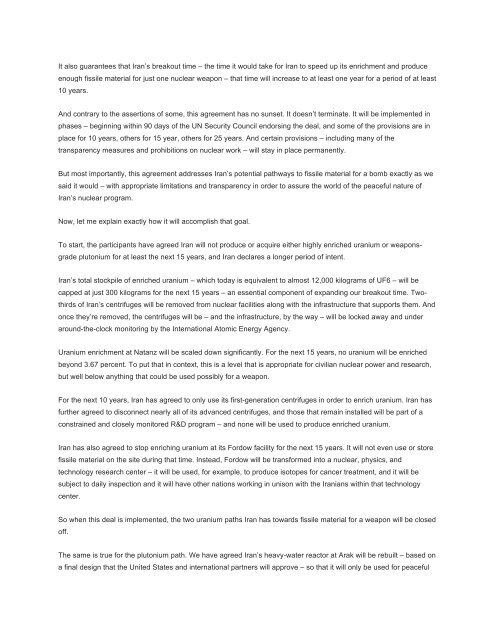WHAT YOU NEED TO KNOW ABOUT THE JCPOA
jcpoa_what_you_need_to_know
jcpoa_what_you_need_to_know
- No tags were found...
You also want an ePaper? Increase the reach of your titles
YUMPU automatically turns print PDFs into web optimized ePapers that Google loves.
It also guarantees that Iran’s breakout time – the time it would take for Iran to speed up its enrichment and produceenough fissile material for just one nuclear weapon – that time will increase to at least one year for a period of at least10 years.And contrary to the assertions of some, this agreement has no sunset. It doesn’t terminate. It will be implemented inphases – beginning within 90 days of the UN Security Council endorsing the deal, and some of the provisions are inplace for 10 years, others for 15 year, others for 25 years. And certain provisions – including many of thetransparency measures and prohibitions on nuclear work – will stay in place permanently.But most importantly, this agreement addresses Iran’s potential pathways to fissile material for a bomb exactly as wesaid it would – with appropriate limitations and transparency in order to assure the world of the peaceful nature ofIran’s nuclear program.Now, let me explain exactly how it will accomplish that goal.To start, the participants have agreed Iran will not produce or acquire either highly enriched uranium or weaponsgradeplutonium for at least the next 15 years, and Iran declares a longer period of intent.Iran’s total stockpile of enriched uranium – which today is equivalent to almost 12,000 kilograms of UF6 – will becapped at just 300 kilograms for the next 15 years – an essential component of expanding our breakout time. Twothirdsof Iran’s centrifuges will be removed from nuclear facilities along with the infrastructure that supports them. Andonce they’re removed, the centrifuges will be – and the infrastructure, by the way – will be locked away and underaround-the-clock monitoring by the International Atomic Energy Agency.Uranium enrichment at Natanz will be scaled down significantly. For the next 15 years, no uranium will be enrichedbeyond 3.67 percent. To put that in context, this is a level that is appropriate for civilian nuclear power and research,but well below anything that could be used possibly for a weapon.For the next 10 years, Iran has agreed to only use its first-generation centrifuges in order to enrich uranium. Iran hasfurther agreed to disconnect nearly all of its advanced centrifuges, and those that remain installed will be part of aconstrained and closely monitored R&D program – and none will be used to produce enriched uranium.Iran has also agreed to stop enriching uranium at its Fordow facility for the next 15 years. It will not even use or storefissile material on the site during that time. Instead, Fordow will be transformed into a nuclear, physics, andtechnology research center – it will be used, for example, to produce isotopes for cancer treatment, and it will besubject to daily inspection and it will have other nations working in unison with the Iranians within that technologycenter.So when this deal is implemented, the two uranium paths Iran has towards fissile material for a weapon will be closedoff.The same is true for the plutonium path. We have agreed Iran’s heavy-water reactor at Arak will be rebuilt – based ona final design that the United States and international partners will approve – so that it will only be used for peaceful


